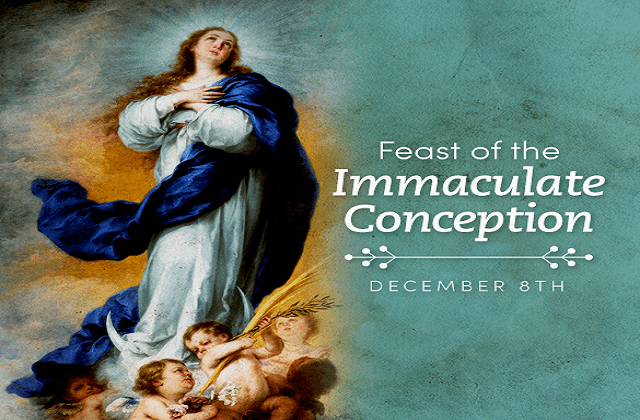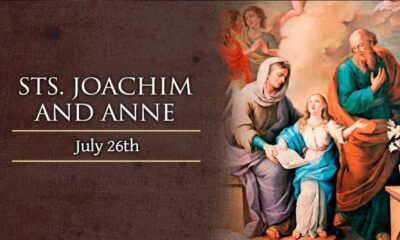Lifestyle
Feast of the Immaculate Conception: History and Significance of the day

Feast of the Immaculate Conception is celebrated by the Roman Catholic Church around the world every year on December 8, nine months before the birthday of Mary, which is celebrated on September 8th. It celebrates the belief in the Immaculate Conception of the Blessed Virgin Mary. The Solemnity of the Immaculate Conception is a holy day of obligation wherein numerous Christians, especially of the Catholic faith, go to special church services for this event. Paraguayans observe it as the Day of the Virgin of Caacupé or the Virgin of Caacupé Day.
It praises the solemn belief that the conception of the Virgin Mary was liberated from original sin. It is a national holiday and has a distinct feel of being the beginning of the Christmas period in Barcelona. It is the day when Catholics celebrate the ‘miraculous conception’ of the Virgin Mary. An enormous percentage of the Spanish populace are Roman Catholics, so for many individuals, it is viewed as a significant day.
When is Immaculate Conception?
The feast is held every year on December 8, which is nine months before the Nativity of Mary, the feast that honors the birthday of Mary. The feast is assigned by Pontificate as the patron feast day in Spain, the U.S., Uruguay, Argentina, Korea, Brazil, and Nicaragua. The royal pronouncement assigned the Virgin Mary as the patron saint in Portugal.
Any Christian holiday that happens in December is always in the shadow of Christmas Day. It is accordingly amazing to some to perceive the number of nations notices this holiday.
On December 8th, numerous nations including Argentina, Austria, Chile, Colombia, Italy, Malta, Portugal, and Spain praise the Feast of the Immaculate Conception with a public holiday.
It is the patronal feast day of Spain, Portugal, Nicaragua, Brazil, the Philippines, and the United States of America. It is celebrated by the Roman Catholic Church as well as a few other firmly related Christian churches.
In the Philippines in 2017, President Duterte signed a law that proclaimed the Solemnity of the Immaculate Conception on December 8th as a national holiday in acknowledgment of the Filipinos’ strong commitment to the Blessed Virgin Mary. This has now become a special working day.
This day is additionally a holiday in Panama, who observe Mother’s Day with a public holiday on the Feast of the Immaculate Conception. Guam additionally observes a public holiday to venerate a statue of Mary on December 8.
History of Immaculate Conception
It is a day that celebrates the belief that Mary, mother of Jesus, was protected from original sin every last bit of her life.
For Roman Catholics, it is seen as a day of obligation with required church participation.
Mary’s mother was St. Anne and her dad was Joachim. While they are not referenced in the bible, their names show up in some early Christian texts. Anne and Joachim had been a childless couple until an angel seemed revealing to Anne that she would bring forth a kid that the world would honor. Anne became a saint as she offered her kid to god’s service.
This day has been praised since at least the 8th century, yet the idea that the word impeccable implies that Mary was born without original sin partitioned numerous religious researchers throughout the centuries. It wasn’t until 1854 that the contention was chosen when Pope Pious IX broadcasted this conviction to be a fundamental authoritative opinion of the Roman Catholic Church.
The Feast of the Immaculate Conception is a legal holiday in Guam, known as Our Lady of Camarin Day, honoring a little wooden statue known as Our Lady of Camarin (Santa Marian Kamalen). The statue is found in the Agana Cathedral Basilica. It has been a tradition since the mid-1900s for the statue to be brought down, groomed, and set on a cart, which is then maneuvered into Hagåtña, Guam’s capital. This statue leads a parade, where individuals implore in different languages to honor Jesus through his mother Mary.
The Immaculate Conception, as indicated by the teaching of the Catholic Church, was the conception of the Blessed Virgin Mary in the womb of her mother, Saint Anne. Mary was considered normally however God kept her spirit perfect, i.e. liberated from original sin. The official affirmation of the dogma was defined in 1854 by Pope Pius IX, even though the belief that Mary was perfect and conceived liberated from sin is very old.
The Feast of Immaculate Conception is celebrated in the Catholic Church on December 8. In numerous nations, it is a holy day of obligation, among others, in the United States, Argentina, Austria, Italy, Portugal, and Spain.
Immaculate Conception is sometimes confused with the conception of Jesus Christ in Mary’s womb, while it refers to Mary herself.
The feast is often celebrated with grand parades, national parades, and cultural festivities to pay tribute to the Blessed Virgin Mary and is commonly viewed as a family day, particularly in Latin American nations.
The celebration of the Feast of the Immaculate Conceptions is seen by traditional (since 1953) visit of the Column of the Immaculate Conception in Piazza di Spagna by the Pope. His expiatory prayers recognize the solemn event.
The feast was assigned a Holy Day of Obligation in 1708 by Pope Clement XI. This feast is frequently celebrated with marches, parades, fireworks, social merriments, and ethnic food to respect the Blessed Virgin Mary. Numerous Catholic nations see this day as Family Day.
-
Health3 weeks ago
Back to Roots: Ayurveda Offers Natural Cure for Common Hair Woes
-

 Tech3 weeks ago
Tech3 weeks agoFrom Soil to Silicon: The Rise of Agriculture AI and Drone Innovations in 2025
-

 Science1 week ago
Science1 week agoJuly Full Moon 2025: Everything You Should Need to Know, When and Where to See Buck Moon
-

 Sports3 weeks ago
Sports3 weeks agoFIBA 3×3 World Cup 2025: Full Schedule, Preview, and How to Watch
-

 Gadget4 weeks ago
Gadget4 weeks agoThings to Know about Samsung Galaxy S26: What’s New and What’s Next
-

 Tech4 weeks ago
Tech4 weeks agoAdobe Firefly App Now Available on iOS and Android Phones to Create AI Images and Videos Anywhere
-

 Sports2 weeks ago
Sports2 weeks agoPrefontaine Classic 2025: Full Schedule, Preview, Field, Events and How to Watch Diamond League Eugene Live
-

 Festivals & Events4 weeks ago
Festivals & Events4 weeks agoEverything You Should Need to Know about Summer Solstice 2025















